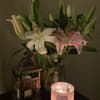Podcast
Questions and Answers
What are enzymes?
What are enzymes?
- Simple, inactive biological molecules
- Specialised, catalytically active biological macromolecules (correct)
- Highly complex, non-specific catalysts
- Inactive proteins found in aqueous solution
Which of the following is true about the classification of enzymes?
Which of the following is true about the classification of enzymes?
- Most enzymes are RNA, while some are DNA
- Enzymes are classified based on their function and the type of reaction they catalyze (correct)
- Enzymes are all classified as globular proteins
- Enzymes are classified based on their physical size only
Which statement accurately describes the nature of the interaction between enzymes and their substrates?
Which statement accurately describes the nature of the interaction between enzymes and their substrates?
- Enzymes bind to substrates but do not affect their chemical structure
- Enzymes interact with substrates through non-covalent bonds and induce a temporary change in the substrate (correct)
- Enzymes and substrates form strong covalent bonds
- Enzymes undergo permanent changes during substrate binding
What is the relevance of enzymes and enzyme inhibition in medicine?
What is the relevance of enzymes and enzyme inhibition in medicine?
Which suffix is commonly added to the name of enzymes?
Which suffix is commonly added to the name of enzymes?
What are the two types of cofactors required by some enzymes?
What are the two types of cofactors required by some enzymes?
Which type of metabolic reaction involves bond formation between molecules to build complex molecules?
Which type of metabolic reaction involves bond formation between molecules to build complex molecules?
What is the 3-D structure of enzymes often referred to as?
What is the 3-D structure of enzymes often referred to as?
Which type of reaction classifies enzymes based on the type of reaction they catalyze?
Which type of reaction classifies enzymes based on the type of reaction they catalyze?
What do enzymes lower to enable metabolic reactions to proceed at a faster rate?
What do enzymes lower to enable metabolic reactions to proceed at a faster rate?
What is the main function of enzymes in metabolic reactions?
What is the main function of enzymes in metabolic reactions?
How do enzymes bind to the substrate?
How do enzymes bind to the substrate?
Which model of enzyme action describes the substrate binding causing a conformational change in the enzyme?
Which model of enzyme action describes the substrate binding causing a conformational change in the enzyme?
What happens to the reaction rate when enzyme concentration increases?
What happens to the reaction rate when enzyme concentration increases?
How does temperature affect enzyme activity?
How does temperature affect enzyme activity?
What is the role of enzymes in metabolic reactions?
What is the role of enzymes in metabolic reactions?
What effect does increasing substrate concentration have on the reaction rate?
What effect does increasing substrate concentration have on the reaction rate?
What happens to enzyme activity at high temperatures?
What happens to enzyme activity at high temperatures?
What does the 'Lock and Key' model describe?
What does the 'Lock and Key' model describe?
What effect does increasing enzyme concentration have on the reaction rate?
What effect does increasing enzyme concentration have on the reaction rate?
What is the effect of decreasing temperature on enzyme activity?
What is the effect of decreasing temperature on enzyme activity?
Study Notes
- Enzymes are named by adding the suffix “-ase” to the name of their substrate or a word describing their catalytic action.
- Enzymes are classified based on the type of reaction they catalyze: Oxidoreductases, Transferases, Hydrolases, Lyases, Isomerases, and Ligases.
- Each enzyme is assigned a four-part classification number and a systematic name that identifies the reaction it catalyzes.
- Enzymes are protein molecules with a globular shape, complex 3-D structure, and an active site where substrates bind.
- Some enzymes require non-protein chemical components called cofactors to function properly.
- There are two types of cofactors: metal ion cofactors and organic/metallo-organic cofactors or cofactors.
- Metal ion cofactors are small inorganic ions that assist with enzyme catalysis, while organic cofactors act as co-substrates or transient carriers of specific functional groups.
- Coenzymes and prosthetic groups are types of organic cofactors that play crucial roles in enzyme function.
- Enzymes catalyze cellular metabolic reactions, which are the sum of chemical reactions that take place in an organism.
- Metabolic reactions include anabolism (biosynthesis) and catabolism (degradation).
- Anabolism involves bond formation between molecules to build complex molecules, while catabolism involves bond breaking to break down complex molecules into simpler ones.
- Anabolism requires energy input and is endergonic, while catabolism releases energy and is exergonic.
- Enzymes lower the activation energy (EA) needed for metabolic reactions to proceed, enabling them to occur at a faster rate.
- Enzymes are essential for life as they catalyze most biochemical reactions in the body and allow life's chemical reactions to proceed at an acceptable rate.
Studying That Suits You
Use AI to generate personalized quizzes and flashcards to suit your learning preferences.
Related Documents
Description
Explore the fundamentals of enzymes in pharmaceutical studies with a focus on enzyme structure, function, kinetics, and inhibition. Dive into the essential concepts of how enzymes interact with substrates and their role in cellular metabolism.





